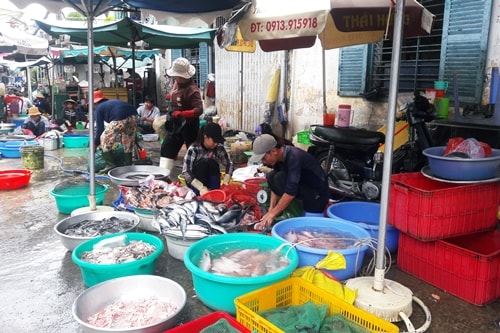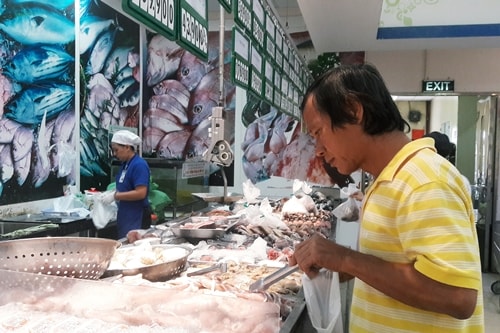Seafood sales are sluggish, freshwater fish are on the rise
After the Ministry of Health's recommendation of 154 types of seafood that should not be eaten in 4 central provinces, the purchasing power of this item in Ho Chi Minh City markets decreased by nearly half.
Ms. Dao (living in Binh Thanh district) said that because she has small children in the house, she always creates a menu that ensures adequate nutrition, which often includes sea fish. However, after being advised not to use some seafood from the Central region, she switched to eating shrimp and fish living in freshwater and brackish water instead of all seafood.
“I don’t know exactly whether the seafood in the market is from the Central region or not, so it’s safest to not eat it for now,” said Ms. Dao. Sharing this sentiment, many housewives said they have limited their consumption of sea fish since the news of the environmental incident in the Central region’s seas broke out.
 |
Seafood sales in Ho Chi Minh City markets are increasingly sluggish. Photo: Phuong Dong. |
Surveys at some large markets in Ho Chi Minh City show that the sea fish business area has very few customers, and both the quantity and variety of products are not diverse. Although the traders advertise that the products are imported from the West and Binh Thuan, ensuring fresh quality, most housewives are not interested. Meanwhile, brackish and freshwater aquatic products such as eels, frogs, field crabs, red tilapia, tilapia, etc. are selling very well and the price has been pushed up by a few thousand VND per kilogram.
Although she has not yet received information about the new recommendations of the Ministry of Health, Ms. Minh, the owner of a freshwater fish stall at An Nhon market (Go Vap) said that in recent days, the purchasing power of this item has increased very strongly. Typically, red tilapia, consumed approximately 100 kg per day with a price of about 60,000 VND per kg for fresh fish and 45,000 - 50,000 VND per kg for suffocated fish.
On the other hand, a seafood trader at Ba Chieu market said he has been selling this product for nearly 10 years, but the slump has only happened in the past few months. Previously, it was normal for silver pomfret, mackerel, tuna, etc. to sell about 60-70 kg per day, but now it has dropped by more than half.
“Before, I always imported sea fish from traders in the West because the transportation distance was short, the price was reasonable, and I didn’t have to worry about contamination like seafood from the Central region. However, since the Formosa incident, the origin of seafood has been equated, making trading very difficult,” she said.
 |
At supermarkets, purchasing power is also not very positive. Photo: Phuong Dong. |
At some supermarkets in the Big C and Co.opmart systems, fresh and frozen seafood are clearly listed as having their origins exploited from key fishing grounds in the south such as Kien Giang, Ca Mau, Ba Ria - Vung Tau... Some types of seafood such as mullet (67,000 VND per kg), silver pomfret (70,000 VND per kg) although their prices are equivalent to many types of freshwater fish, are not chosen by many consumers.
“Information about the origin, processing facility and price are clearly shown on the packaging, but many consumers are still not satisfied and sometimes have to ask the staff at the counter,” said the manager of the fresh food department at Co.opmart Ly Thuong Kiet supermarket (District 10). According to this employee, in the past few days, the purchasing power of freshwater fish and pre-processed seafood has been on the rise.
Mr. Nguyen Huu Dinh, owner of Thanh Hung seafood warehouse (Tan Binh district), said that the origin-based comparison has significantly affected the business activities of this enterprise. While people are boycotting seafood, he has proactively sought a new direction, bringing his products to the central coastal provinces. Currently, this warehouse distributes more than half a ton of various types of seafood to Thanh Hoa and Nghe An every day.
“Consumers can rest assured when eating seafood because most of the products consumed in the Ho Chi Minh City market are not imported from the Central provinces due to very high preservation and transportation costs and the quality is not special,” Mr. Dinh added.
Regarding businesses in the four central provinces affected by the environmental incident, Mr. Nguyen Thanh Ngoc, owner of Ngoc Phuong fishing enterprise (Dong Hoi, Quang Binh) said that the new recommendations make fishing for fishermen here even more difficult.
“Now everything has changed. My seafood shop for tourists had to close due to a 95% decrease in customers, the boat had to increase its capacity to operate far from shore to avoid contaminated seafood, but when selling, people still did not dare to buy, traders forced down the price, typically, mackerel of 18-19 pieces per kilo sold for only 15,000 VND, while just a few months ago it was up to more than 30,000 VND,” Mr. Ngoc said.
Recently, the Institute of Marine Research has announced a list of 154 types of bottom-dwelling seafood such as crabs, shrimp, mantis shrimp, snails, squid, stingrays, octopus, etc. within 20 nautical miles of the four central provinces of Ha Tinh, Quang Binh, Quang Tri, and Thua Thien - Hue. The Ministry of Health recommends that people should not use these types of seafood because they are not yet safe. In particular, seafood living on the surface and in the ponds of these four provinces has been guaranteed to be safe, specifically tuna, mackerel, mackerel of all kinds, yellowstripe scad, silver pomfret, hairtail, cowfish, orange croaker, herring, mullet, and anchovy. |
According to VNE
| RELATED NEWS |
|---|

